Abstract
In Japan’s winter/spring eggplant farming, harvest yield, planting area, and shipping volume are important indicators. As per the data for 2022, the national winter-spring eggplant harvest is up to 115kt, with the planted area up to 1.03kha and shipping volume up to 37.8kt in Kochi. Based on past trends, eggplant production in Japan has been stable nationwide, with Kochi in particular standing out as its center. Additionally, when cultivating winter-spring eggplant, climatic conditions and regional characteristics can affect production volume. As a result, while production and shipping volumes vary from region to region, there has also been a trend toward increased overall harvests and shipping volumes due to improvements in agricultural technology and production systems. In the future, the development of cultivation techniques and marketing strategies that take advantage of regional characteristics will likely support the growth of winter/spring eggplant agriculture in Japan.
Winter-spring eggplant harvest volume (main data).
Japan’s winter-spring eggplant harvest shows various characteristics and trends from 1973 to 2022. At its peak in 1999, the national harvest was recorded at 169kt, but currently it is only 68% of that, or 115kt. During this time, harvest yields fluctuate due to advances in agricultural technology and changes in economic conditions. For example, changes in agricultural policies and the impact of climatic conditions are also major factors. Changes in demand and consumption patterns also affect yields. In recent years, there has been an increased emphasis on food safety and local production for local consumption, and in response, production systems and cultivation techniques are being improved. On the other hand, issues such as population decline and a decrease in the agricultural labor force are also having an impact. Going forward, challenges will include promoting sustainable agriculture, technological innovation, and adapting to market needs, but it is expected that Japan’s winter-spring eggplant farming will see new developments while making use of its history and traditions.
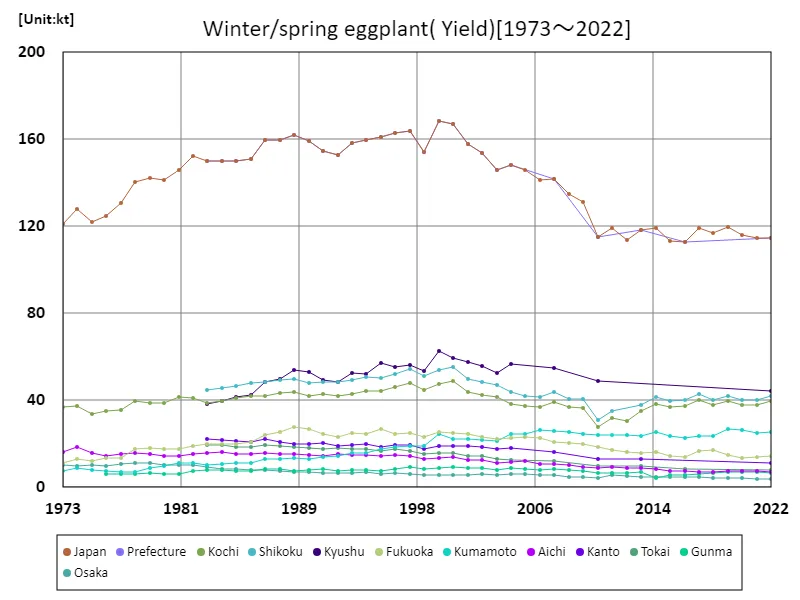

The maximum is 169kt[1999] of Japan, and the current value is about 68%
Winter-spring eggplant harvest volume (by prefecture).
Data from 2022 reveals some characteristics and trends regarding Japan’s fruit vegetable harvests. According to the latest data, Kochi recorded the highest overall yield of 39.6kt, breaking the previous record. This result indicates that Kochi plays an important role in fruit and vegetable production. On the other hand, other prefectures are also actively engaged in fruit and vegetable production, which may lead to increased competition. Advances in agricultural technology, greater efficiency, and the utilization of local resources may be contributing to increased yields. It is also believed that the increase in demand for fruit and vegetables is due to consumers becoming more health conscious and changes in food culture. In the future, establishing production systems and developing marketing strategies that are tailored to the characteristics and demand of each region will likely be important issues in increasing fruit and vegetable harvests.
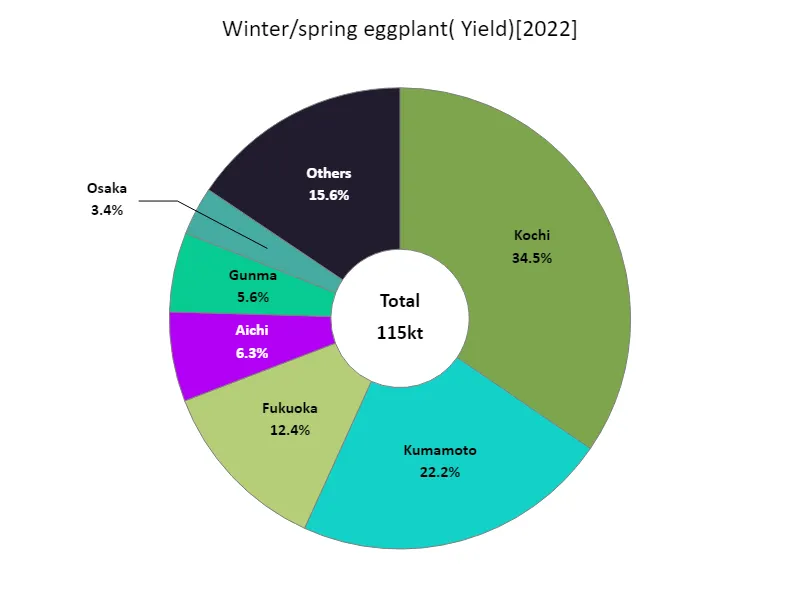

The maximum is 39.6kt of Kochi, the average is 3.58kt, and the total is 115kt
Winter-spring eggplant planting area (main data).
The characteristics and trends of winter/spring eggplant planting area in Japan can be seen from data from 1973 to 2022. At its peak in 1973, the total area cultivated across the country was recorded to be 1.94kha, but currently, the area cultivated is only about half of that, at 53.1%. During this time, changes in agricultural structure, fluctuations in demand, and regional competition have all had an impact. Changes in agricultural policies and domestic and international economic conditions are also affecting the area under cultivation. Changing consumer eating habits and an increase in imports may also be contributing to the decline in planted area. On the other hand, there are also regions where efficient production systems have been established through advances in agricultural technology, increased efficiency, and the utilization of local resources. In the future, it will be important to secure appropriate cultivated areas that take into account changes in demand and the characteristics of each region. At a time when there is a need to promote sustainable agriculture and improve productivity, it will be necessary to establish an effective production system while taking into account the declining area of land used for winter-spring eggplant cultivation.
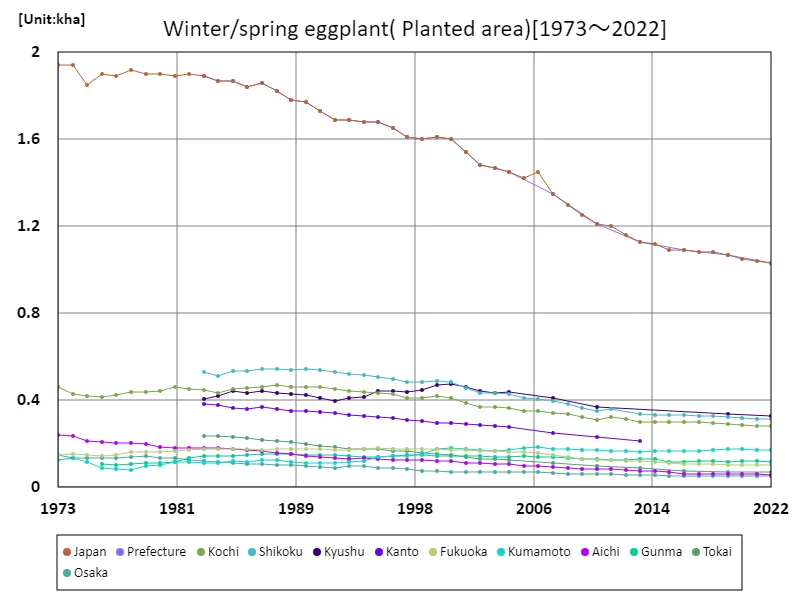

The maximum is 1.94kha[1973] of Japan, and the current value is about 53.1%
Winter/spring eggplant cultivation area (by prefecture).
Several characteristics emerge from the 2022 data on the area of land planted to fruit vegetables in Japan. According to the latest data, Kochi recorded the highest total cultivated area of 283 hectares, breaking the previous record. This suggests that Kochi’s fruit and vegetable production is outstanding. On the other hand, it is clear that other prefectures are also actively involved in fruit and vegetable production. Different regions have different climatic and soil conditions, which may allow each region to allocate optimal planting area and maximize production efficiency. Additionally, advances in agricultural technology and the promotion of sustainable agriculture are also thought to have contributed to the expansion of cultivated area. Because fruit vegetables are in high demand, it is important for producers to respond quickly to market needs and establish efficient production systems. In the future, it will be necessary to build a sustainable production system that can respond flexibly to regional characteristics and changes in demand.
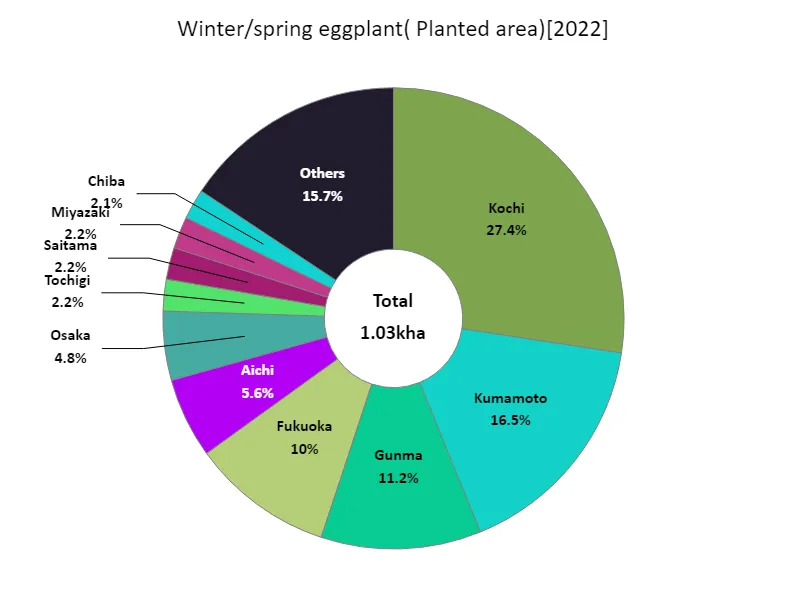

The maximum is 283ha of Kochi, the average is 32.3ha, and the total is 1.03kha
Winter-spring eggplant shipping volume.
Several characteristics emerge from the 2022 data on Japan’s winter-spring eggplant shipments. The latest data shows Kochi recorded the highest overall shipment of 37.8kt, the highest so far. Additionally, the overall average shipping volume was 3.37kt, bringing the overall total to 108kt. This data makes it clear that Kochi is a very important producer of winter-spring eggplant. Shipments are also being made actively from areas other than Kochi, indicating that there is demand nationwide. Winter and spring eggplants occupy an important position in Japanese food culture, and demand for them appears to be stable. Additionally, advances in agricultural technology and improved production efficiency are thought to have contributed to the increase in shipping volumes. On the other hand, annual harvest and shipping volumes can fluctuate due to factors such as climatic conditions and natural disasters. In the future, it will be necessary to establish a sustainable production system while taking into account changes in demand and environmental considerations.
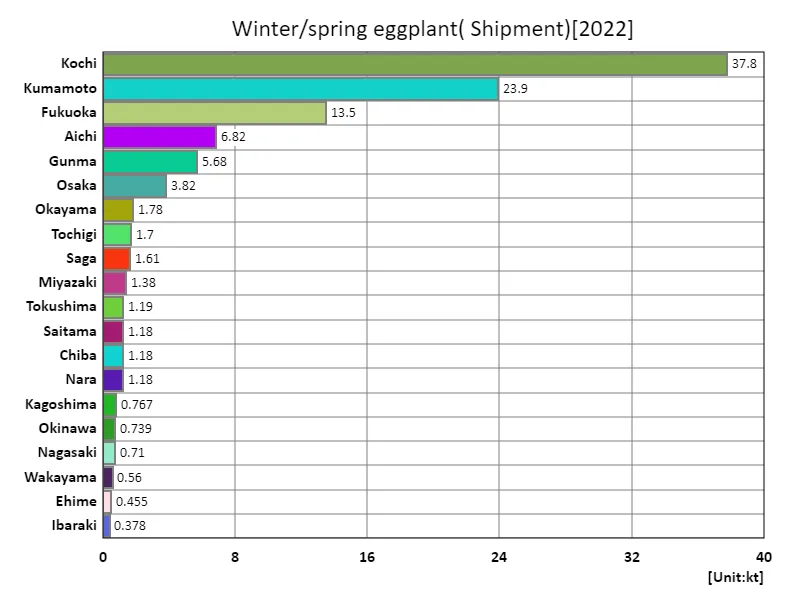

The maximum is 37.8kt of Kochi, the average is 3.37kt, and the total is 108kt



Comments